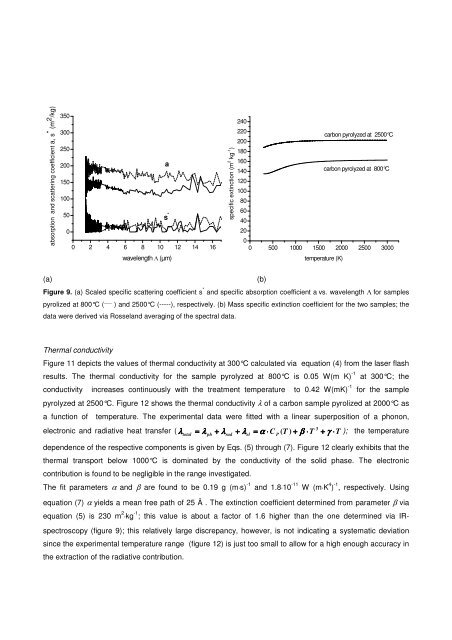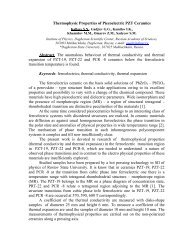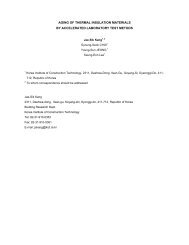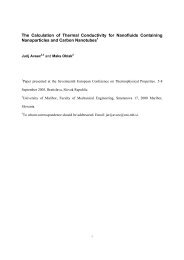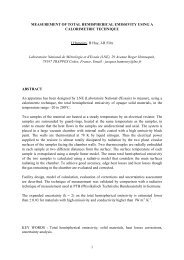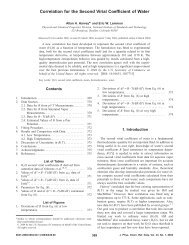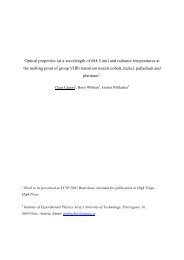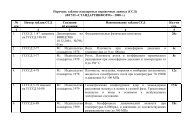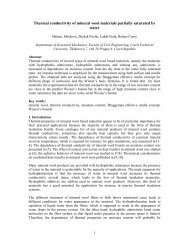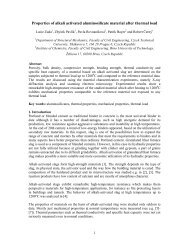Thermal conductivity of amorphous carbon as a ... - thermophysics.ru
Thermal conductivity of amorphous carbon as a ... - thermophysics.ru
Thermal conductivity of amorphous carbon as a ... - thermophysics.ru
Create successful ePaper yourself
Turn your PDF publications into a flip-book with our unique Google optimized e-Paper software.
absorption and scattering coefficient a, s * (m 2 /kg)<br />
350<br />
300<br />
250<br />
200<br />
150<br />
100<br />
50<br />
0<br />
0 2 4 6 8 10 12 14 16<br />
wavelength Λ (µm)<br />
a<br />
s *<br />
specific extinction (m 2 kg -1 )<br />
240<br />
220<br />
200<br />
180<br />
160<br />
140<br />
120<br />
100<br />
80<br />
60<br />
40<br />
20<br />
<strong>carbon</strong> pyrolyzed at 2500°C<br />
<strong>carbon</strong> pyrolyzed at 800°C<br />
0<br />
0 500 1000 1500 2000 2500 3000<br />
temperature (K)<br />
(a)<br />
(b)<br />
Figure 9. (a) Scaled specific scattering coefficient s * and specific absorption coefficient a vs. wavelength Λ for samples<br />
pyrolized at 800°C ( ___ ) and 2500°C (-----), respectively. (b) M<strong>as</strong>s specific extinction coefficient for the two samples; the<br />
data were derived via Rosseland averaging <strong>of</strong> the spectral data.<br />
<strong>Thermal</strong> <strong>conductivity</strong><br />
Figure 11 depicts the values <strong>of</strong> thermal <strong>conductivity</strong> at 300°C calculated via equation (4) from the l<strong>as</strong>er fl<strong>as</strong>h<br />
results. The thermal <strong>conductivity</strong> for the sample pyrolyzed at 800°C is 0.05 W(m K) -1 at 300°C; the<br />
<strong>conductivity</strong> incre<strong>as</strong>es continuously with the treatment temperature to 0.42 W(mK) -1 for the sample<br />
pyrolyzed at 2500°C. Figure 12 shows the thermal <strong>conductivity</strong> λ <strong>of</strong> a <strong>carbon</strong> sample pyrolized at 2000°C <strong>as</strong><br />
a function <strong>of</strong> temperature. The experimental data were fitted with a linear superposition <strong>of</strong> a phonon,<br />
electronic and radiative heat transfer ( λ<br />
total<br />
3<br />
= λ + λ + λ = α ⋅ ( T ) + β ⋅T<br />
+ γ ⋅T<br />
); the temperature<br />
ph<br />
rad<br />
dependence <strong>of</strong> the respective components is given by Eqs. (5) through (7). Figure 12 clearly exhibits that the<br />
thermal transport below 1000°C is dominated by the <strong>conductivity</strong> <strong>of</strong> the solid ph<strong>as</strong>e. The electronic<br />
contribution is found to be negligible in the range investigated.<br />
The fit parameters α and β are found to be 0.19 g (m·s) -1 and 1.8·10 -11 W (m·K 4 ) -1 , respectively. Using<br />
equation (7) α yields a mean free path <strong>of</strong> 25 Å . The extinction coefficient determined from parameter β via<br />
equation (5) is 230 m 2·kg -1 ; this value is about a factor <strong>of</strong> 1.6 higher than the one determined via IRspectroscopy<br />
(figure 9); this relatively large discrepancy, however, is not indicating a systematic deviation<br />
since the experimental temperature range (figure 12) is just too small to allow for a high enough accuracy in<br />
the extraction <strong>of</strong> the radiative contribution.<br />
el<br />
C P


